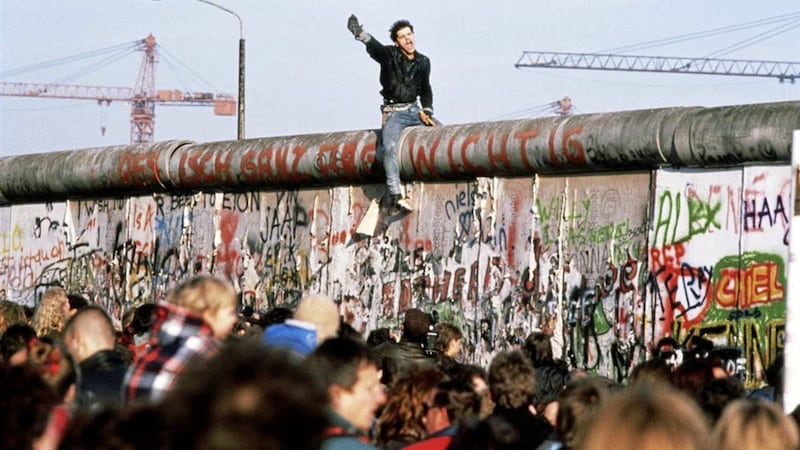In a speech last week, the outgoing German chancellor, Angela Merkel, made a plea to her fellow countrywomen and men asking that they continue to pursue the German unification project.
Speaking some 31 years after Germany was officially reunified, she claimed that “mentally and structurally, unification hadn’t been completed yet.”
She was referring to cultural and political differences that persist, as well as the fact the west remains significantly wealthier than the east more than a generation after the moment Germany again became one.
Images of the Berlin Wall being torn down by residents of a city which defined the Cold War like no other represented the beginning of a long and difficult journey to reconcile a people divided for 40 years into two separate states, systems and shared experiences.
Sound familiar?
Of course, Germans shared a common sense of national identity and were divided by the ideological stances of political elites, which should have made their union a much smoother process than what we can realistically hope for in Ireland.
Yet, just as was the case in Germany, the process in Ireland is destined to be fraught with challenges and setbacks.
When a vote is eventually won to secure Irish unity, it will almost certainly be against the wishes of some 45 per cent-plus of the population of the north of Ireland.
Regardless of the border poll’s outcome, there will still be contentious parades, political disagreements over identity matters and a chasm separating opinions on commemorations and narratives of our past. Anyone who has studied the history of America’s Deep South after the civil war will also appreciate this point.
In other words, the fanciful notion that Irish unity will be pre-dated by a Damascene conversion by unionists to the nationalist cause is utter nonsense.
Accepting that reality is an important step in properly and pragmatically planning for unification.
Nationalists are obliged to encourage support for the unity vision, not least amongst those who may have been hostile or indifferent to the ideal in the past. That will entail embracing new vocabulary, ideas and approaches as well as demonstrating a genuine desire to accommodate even those for whom unity will represent the doomsday scenario.
But the reality of significant communal opposition to unity should not detract supporters from working openly and enthusiastically for the objective, within the existing political institutions and across wider society more generally.
The state of Northern Ireland has existed for a century now. Almost 25 years have passed since the Good Friday Agreement yet the desire for Irish reunification has only become stronger because the logic of unity is overwhelming.
That has not prevented opponents of unity, north and south, from attempting to raise every obstacle possible in a vain effort to stymie the developing clamour for change.
A favourite tactic has been to proclaim Irish unity should not be considered until it is something actively supported by unionists, tantamount to handing a veto over discussions on unity to the Four Tops of unionism who gathered in Stormont at the Orange Order’s behest on the anniversary of Ulster Day to sing the same old song last month.
Another tactic is to claim that the time is simply not right to even discuss, never mind support, the proposal.
It was the second tactic which former DUP MP Emma Little Pengelly employed last week during a radio discussion with former Alliance MLA, Trevor Lunn. The Lagan Valley politician was in the news after he proposed a motion to the assembly calling upon politicians of all shades to support a citizens' assembly to begin exploring what Irish unity could look like.
Pengelly claimed the proposal was “the wrong issue at the wrong time”, suggesting people would be better discussing other matters. Her position was disingenuous. For an avowed unionist, there will never be a good time to talk about - never mind lobby- for Irish unity.
This is why the DUP seized the opportunity recently to begin an official boycott of North-South institutions. They have rarely engaged productively in these meetings and, with Sinn Féin now surging some 10 points clear as the largest political party in the south, it is unlikely any unionist party will seek to meaningfully engage with North-South bodies as to do so would be to concede to the inescapable logic that greater island-wide co-operation is an inherently good thing.
Nationalist politicians need to learn the lesson quickly.
Waiting on political unionism to signal approval for others to plan and work for Irish unity is illogical.
The Irish government needs to introduce a step change in planning for unity. Their Shared Island initiative to this point remains stuck in first gear. Dublin must do more than simply regurgitate old commitments over canals, a bridge and a road yet to be built. The Irish government should be directly working with northern political parties outside of the now defunct North-South bodies to agree policies and promote effective all-island planning at council and assembly level.
The lesson from Germany is clear.
Uniting Ireland is a long term project, but the act of forming a sovereign political union is the major step along that road. Irish unity will be the precursor to the eventual unity of people across Ireland.









